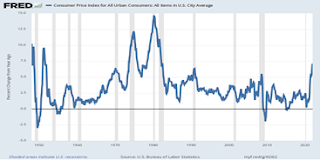Will inflation keep rising, squeezing consumers, or return to a more normal range this year? The Consumer Price Index (CPI) that measures retail goods and services rose to 7.1 percent in December and has forced the Fed to promise to raise interest rates several times to ‘tame’ a rising inflation rate that seems to worry the pundits and bankers more than most consumers.
That’s because once the Fed starts taking money out of circulation by selling the $4 trillion plus in securities it’s holding, the money supply should shrink and thus take away the punch bowl of easy money that has prevailed during the pandemic and pushed the financial markets to record highs.
So, the debate du jour is can the Fed take away the punchbowl without sinking the economy into another recession? There’s a lot of money in circulation, thanks to all the pandemic aid, but what happens when it’s withdrawn? The hope is for what is called a ‘soft landing’, a slowing of economic activity that doesn’t morph into an economic slump.
It would be nice if inflation could tame itself without too much government intervention. Inflation could moderate this year because consumers annually cut back on spending after the holidays to pay down their credit cards and save for the income tax season.
But even so, the Fed must act to look like it’s on the ball by making noises that it’s ready to raise the price of borrowed money by acting preemptively. That is supposed to lower inflation expectations and thus dis-incentivize consumers and businesses from rushing to buy before the next price rise.
Do such expectations of future inflation really affect consumers’ behavior? That’s still an open question among economists.
And the answer is much more complicated today because this inflation is caused by a serious shortage—of goods, services, and employees to manufacture and distribute them.
So all of this is in turn dependent on the course of the ongoing COVID-19 pandemic that is keeping workers away from work, and causing the supply chain bottlenecks.
As a side note, a recent study by two UC Davis Labor economists in Econofact.org — Labor Shortages and the Immigration Shortfall, posits that part of the labor shortage is due to a shortfall in immigrants over the past two years—some 2 million working age adults—due to restrictions placed on immigration from the pandemic.
And approximately 1 million are college-educated, which could impact productivity and employment over the longer term.
They cite other causes for the labor shortage, such as increased retirement and increased bargaining power of workers as playing an important role.
The authors also contend, “While more generous unemployment and welfare benefits introduced during the crisis may have discouraged workers from taking low-paying jobs in 2020 and early 2021, they do not seem to be the cause of current shortages, since most of those benefits expired by mid-2021. Recent anecdotal and preliminary evidence finds a push by workers for more job-flexibility, safety and, generally, better conditions causing resignations and contributing to unfilled job openings.”
So the labor shortage could last for years, unless Washington and Congress get their immigration act together. Immigration has historically been a major source of U.S. population and job growth.
In fact, we shouldn’t forget that we are a nation of immigrants that has always been dependent on immigrants, and the effect of the immigration shortfall is much more worrisome than inflation because studies show they bring a high level of skills that are good for economic growth.
So even speeding up approval of a backlog of 460,000 entry visas cited by the State Department as still unprocessed could make this a softer landing.
Harlan Green © 2022
Follow Harlan Green on Twitter: https://twitter.com/HarlanGreen


No comments:
Post a Comment